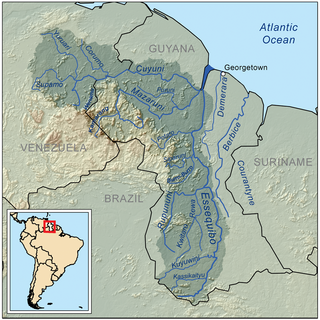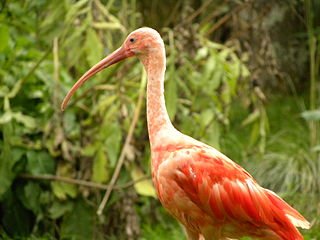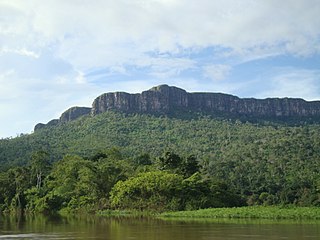This article needs additional citations for verification .(February 2017) |
WWF (World Wildlife Fund) Guianas is an international conservation NGO, part of the WWF global network.
This article needs additional citations for verification .(February 2017) |
WWF (World Wildlife Fund) Guianas is an international conservation NGO, part of the WWF global network.
WWF's main mission is "to stop the degradation of the planet's natural environment and to build a future in which humans live in harmony with nature." The regional office of WWF Guianas is also involved in a plurality of site specific objectives, often in partnership with civil society organizations and government institutions such as Conservation International and Iwokrama International Centre for Rain Forest Conservation and Development. These range from the protection and management of ecological landscapes, to educational and awareness campaigns on climate change, biodiversity and conservation.
The three Guianas (Guyana, Suriname and French Guiana) have between 80 and 98% pristine forest cover and are part of the complex ecosystem of The Guiana Shield freshwater ecoregion, which provides 15% of the world's freshwater reserves. The forests, wetlands, savannah, waters and biodiversity make the Guiana Shield "essential to enriching and replenishing the world's biodiversity and, consequently, essential to the planet's survival" as Brigadier David Granger - President of the Cooperative Republic of Guyana pointed out [6] during his speech at the Opening Ceremony of the IVth International Congress on Biodiversity of the Guiana Shield. [7] It is also the home of incredible wildlife creatures such as jaguars, anteaters, anacondas, caimans, bats, and sea turtles. A phenomenal variety of fishes populate its waters, and a prodigious amount of different bird species inhabits its trees and skies. The coasts of the Guianas are home to one of the largest populations of the endangered leatherback turtle in the world and hosts millions of migratory birds from North America. Typical Guiana birds include the red ibis and the cock-of-the-rock. Multiple Indigenous communities live in key parts of the Shield such as the Iwokrama Forest or the Rupununi region.
The regional office of WWF Guianas is located in Paramaribo, Suriname. Country offices are also located in Georgetown, Guyana, and Cayenne, French Guiana. Laurent Kelle is the WWF French Guiana Country Office.

The Tumucumaque Mountains National Park is situated in the Amazon Rainforest in the Brazilian states of Amapá and Pará. It is bordered to the north by French Guiana and Suriname.

The Guiana Shield is one of the three cratons of the South American Plate. It is a 1.7 billion-year-old Precambrian geological formation in northeast South America that forms a portion of the northern coast. The higher elevations on the shield are called the Guiana Highlands, which is where the table-like mountains called tepuis are found. The Guiana Highlands are also the source of some of the world's most well-known waterfalls such as Angel Falls, Kaieteur Falls and Cuquenan Falls.

Wildlife conservation refers to the practice of protecting wild species and their habitats in order to maintain healthy wildlife species or populations and to restore, protect or enhance natural ecosystems. Major threats to wildlife include habitat destruction, degradation, fragmentation, overexploitation, poaching, pollution, climate change, and the illegal wildlife trade. The IUCN estimates that 42,100 species of the ones assessed are at risk for extinction. Expanding to all existing species, a 2019 UN report on biodiversity put this estimate even higher at a million species. It is also being acknowledged that an increasing number of ecosystems on Earth containing endangered species are disappearing. To address these issues, there have been both national and international governmental efforts to preserve Earth's wildlife. Prominent conservation agreements include the 1973 Convention on International Trade in Endangered Species of Wild Fauna and Flora (CITES) and the 1992 Convention on Biological Diversity (CBD). There are also numerous nongovernmental organizations (NGO's) dedicated to conservation such as the Nature Conservancy, World Wildlife Fund, and Conservation International.

The Rupununi is a region in the south-west of Guyana, bordering the Brazilian Amazon. The Rupununi river, also known by the local indigenous peoples as Raponani, flows through the Rupununi region. The name Rupununi originates from the word rapon in the Makushi language, in which it means the black-bellied whistling duck found along the river.

The Iwokrama Forest is a 3,716 square kilometres (1,435 sq mi) nature reserve of central Guyana located in the heart of the Guiana Shield, one of the four last pristine tropical forests in the world. It represents an important transition zone in rainfall, landforms, human histories and biological communities.
The Iwokrama International Centre for Rain Forest Conservation and Development is an autonomous non-profit institution established by Guyana and the Commonwealth. It "exists to promote the conservation and the sustainable and equitable use of tropical rain forests in a manner that leads to lasting ecological, economic, and social benefits to the people of Guyana and to the world in general, by undertaking research, training, and the development and dissemination of technologies".

Rio Trombetas Biological Reserve is a federally-administered biological reserve in the municipality of Oriximiná, Pará, Brazil. It covers a large area of Amazon biome including rainforest, wetlands and water.

Jari Ecological Station is an ecological station in Brazil, located in the states of Amapá and Pará, created in 1984.

Earthwatch Institute is an international environmental charity. It was founded in 1971 as Educational Expeditions International by Bob Citron and Clarence Truesdale. Earthwatch Institute supports Ph.D. researchers internationally and conducts over 100,000 hours of research annually using the Citizen Science methodology. Earthwatch's mission statement states that the organization "connects people with scientists worldwide to conduct environmental research and empowers them with the knowledge they need to conserve the planet." As such, it is one of the global underwriters of scientific field research in climate change, archaeology, paleontology, marine life, biodiversity, ecosystems and wildlife. For over fifty years, Earthwatch has raised funds to recruit individuals, students, teachers, and corporate fellows to participate in field research to understand nature's response to accelerating global change.

The wildlife of Canada or biodiversity of Canada consist of over 80,000 classified species, and an equal number thought yet to be recognized. Known fauna and flora have been identified from five kingdoms: protozoa represent approximately 1% of recorded species; chromist ; fungis ; plants ; and animals. Insects account for nearly 70 percent of documented animal species in Canada. More than 300 species are found exclusively in Canada.
The North Rupununi District in located in south-west Guyana consisting of a mixture of forest, savannah and wetlands ecosystems and is considered one of the most diverse areas in South America. Located on the eastern margin of the larger savannah system which extends into Brazil and is separated by the Ireng and Takutu rivers that come together to form the Rio Branco. The Guyana Rupununi system is divided into the North and South Rupununi by the Kanuku Mountains.

The Amazon biome contains the Amazon rainforest, an area of tropical rainforest, and other ecoregions that cover most of the Amazon basin and some adjacent areas to the north and east. The biome contains blackwater and whitewater flooded forest, lowland and montane terra firma forest, bamboo and palm forest, savanna, sandy heath and alpine tundra. Some areas of the biome are threatened by deforestation for timber and to make way for pasture or soybean plantations.

Biodiversity in Suriname is high, mostly because of the variety of habitats and the temperature. The average annual temperature in the coastal area is between 26° and 28°C. Suriname can be divided into four major ecological zones, namely from north to south;

The Guianan savanna (NT0707) is an ecoregion in the south of Venezuela, Guyana and Suriname and the north of Brazil. It is in the Amazon biome. The savanna covers an area of rolling upland plains on the Guiana Shield between the Amazon and Orinoco basins. It includes forested areas, but these are shrinking steadily due to the effect of frequent fires, either accidental or deliberate. The ecoregion includes the Gran Sabana region of Venezuela.

The Guayanan Highlands moist forests (NT0124) is an ecoregion in the south of Venezuela, the north of Brazil, and also within Guyana, Suriname, and French Guiana. It is in the Amazon biome. It encompasses an upland region with diverse fauna and flora, which contains dramatic tepuis, or sandstone table mountains. The region has been inaccessible in the past and is generally fairly intact, apart from the north and northeast where large scale agriculture, ranching and mining operations are steadily encroaching on the ecosystem. New roads are opening the interior to logging, and planned dams will have a drastic impact on the riparian zones.

The Guianan moist forests (NT0125) is an ecoregion in the east of Venezuela, north of Brazil and the Guyanas. It is in the Amazon biome. The climate is hot and humid, with two rainy seasons each year. As of 1996 the tropical rainforest habitat was relatively intact, although there were mounting threats from illegal logging and gold mining.

The Amazon–Orinoco–Southern Caribbean mangroves (NT1401) is an ecoregion along the coasts of Colombia, Venezuela, Guyana, Suriname, French Guiana and Brazil.

The Guianan mangroves (NT1411) is a coastal ecoregion of southeastern Venezuela, Guyana, Suriname, French Guiana and Brazil. The mangroves provide an important habitat for migrating birds that winter in the area. Large areas are intact, although they are threatened by destruction of the trees for timber and to make way for agriculture, and from upstream agricultural and industrial pollution.

The Guianan marine ecoregion stretches along the middle of the northeast coast of South America, touching Venezuela, Guyana, Suriname and French Guiana. It extends about 200 miles offshore, with the warm Guianan Current moving east-to-west through the region. This current brings in fresh, turbid waters from the mouth of the Amazon River to the east. As the current exits the ecoregion to the west it contributes an estimated 70% of the waters of the Caribbean Sea. A very large oil field has been recently discovered in the Guyana-Suriname Basin of the ecoregion. The Guianan is one of two ecoregions in the North Brazil Shelf province, a Large marine ecosystem (LME). The Guianan is thus part of the larger Tropical Atlantic realm.

The fauna of Guyana comprises all the animal species inhabiting the country of Guyana, which is part of the neotropical realm. Guyana has many endemic species and one of the highest biodiversity rates in the world as a result of the majority of the country being part of the Amazon rainforest, and as a result a large amount of the species being types of frogs or spiders. Guyana's has three distinct main biomes are tropical rainforests, wetlands, and savannas, and each biome has unique fauna associated.